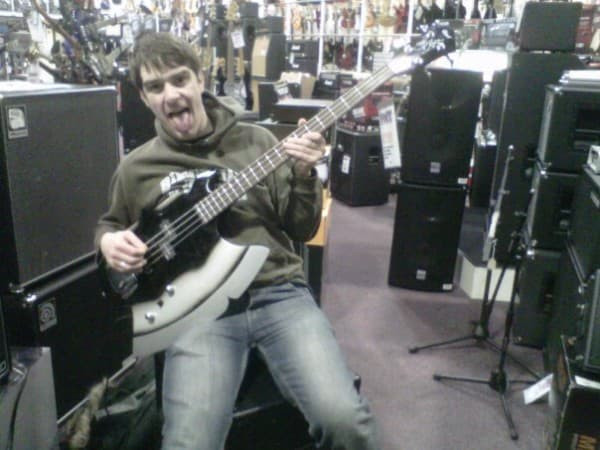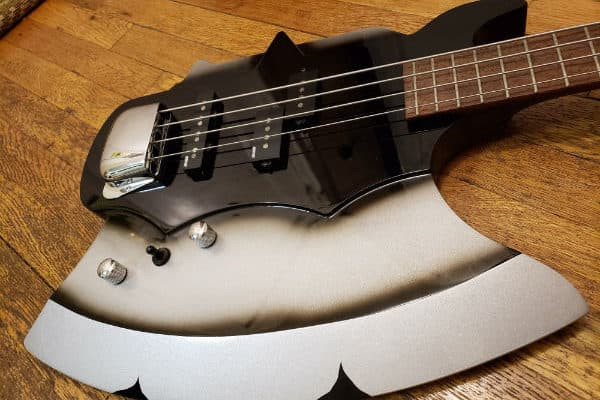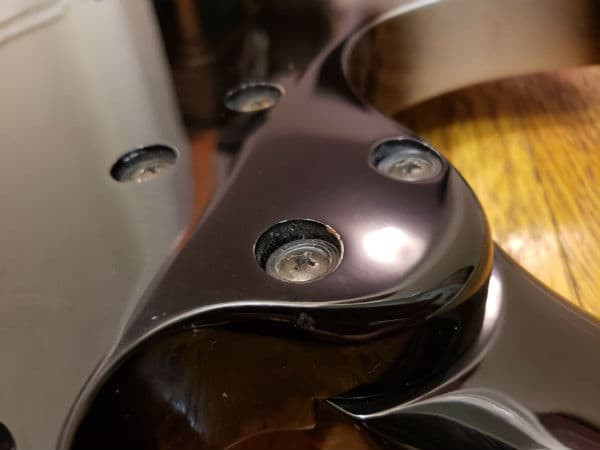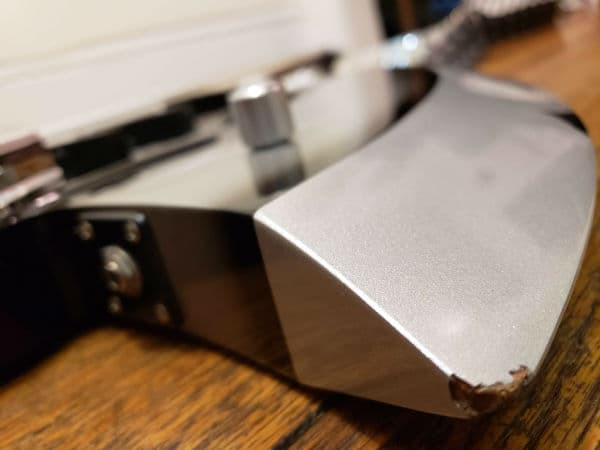The electric bass guitar world is full of iconic shapes and signature instruments, but few are as instantly recognizable and visually arresting as the axe bass. When a signature model also boasts such an unconventional design, it naturally invites extra scrutiny from musicians and gear enthusiasts alike. So, what happens when you combine the legacy of a rock legend with a truly unique instrument shape? Let’s delve into the Cort Gene Simmons Axe Electric Bass Guitar and explore what makes this instrument tick, beyond just its striking appearance.
My Axe Bass Story: Finding a Diamond Axe in Birmingham
Like many, my introduction to KISS came a bit later than their initial explosion onto the scene. Growing up in the 90s, musicians often presented a more understated image. KISS, with their theatricality and larger-than-life personas, were a complete departure from that norm. I was immediately captivated by the spectacle, the music, and yes, even their outlandish instruments. The axe bass, in particular, always stood out – it just looked like pure rock and roll fun.
Fast forward to 2012, and a local music store, PMT Birmingham, posted on their Facebook page that they had a used Cort Gene Simmons Axe Electric Bass Guitar in stock. Coincidence? Fate? Perhaps a bit of both. At the time, I had some spare cash and the memory of that axe bass always lingered in the back of my mind. The following weekend, I found myself heading to Birmingham. Initially priced at £300, I managed to haggle it down to £250. Since then, this unique instrument has become a staple in both live performances and studio recordings.
 Gene Simmons Axe Bass Guitar purchase at PMT Birmingham music store.
Gene Simmons Axe Bass Guitar purchase at PMT Birmingham music store.
Cort Gene Simmons Axe Bass: Unpacking the Specs
Walking into the store, it was clear that detailed information on this particular Cort model was scarce. Thankfully, a quick online search filled in the blanks. Here’s a rundown of the specifications:
| Country of origin | Indonesia |
|---|---|
| Construction type | Bolt-on neck |
| Body material | Mahogany |
| Neck material | Maple |
| Fingerboard material | Rosewood |
| Number of frets | 21 |
| Pickup configuration | Mighty Mite MMJB-R and MMPB-4 |
Objectively reviewing these specs, they aren’t going to blow anyone away on paper. If you were presented with this list devoid of context, it’s unlikely to generate much excitement. However, the magic of the Cort Gene Simmons Axe Electric Bass Guitar isn’t purely in its component list; it’s in how these parts come together to create something truly unique.
Construction and Components: More Than Meets the Eye
While I typically appreciate the natural beauty of wood grain, on an instrument shaped like an axe, such aesthetic concerns understandably take a backseat. The core of the axe bass is a mahogany body. While not exotic, mahogany is a respected tonewood, even found in high-end instruments costing thousands. The crucial difference lies in the grade and density of the wood used. Picking up the axe bass, you immediately notice it’s surprisingly lightweight, suggesting a less dense cut of mahogany.
The neck is constructed from maple, topped with a rosewood fingerboard – standard fare for basses in this price range. Similarly, the hardware is chrome-finished and unbranded, typical of instruments manufactured in East Asia. Again, nothing particularly groundbreaking, but functional and reliable.
 Mahogany body of the Cort Gene Simmons Axe Bass guitar.
Mahogany body of the Cort Gene Simmons Axe Bass guitar.
Build Quality: Challenging Preconceptions
It’s easy to fall into the trap of assuming instruments made in certain regions are inherently inferior. This is a particularly prevalent bias among seasoned musicians. However, since the early 2000s, guitars and basses from countries like Korea, China, and Indonesia have significantly improved in quality and craftsmanship.
Examining the Cort Gene Simmons Axe Electric Bass Guitar closely, particularly in areas prone to flaws, reveals a surprisingly high level of construction. The neck joint, often a tell-tale sign of build quality, is clean and precisely fitted. The hardware is securely fastened, and while there’s no binding on the fingerboard, and the neck finish isn’t the slickest available, the overall impression is one of solid construction.
 Bolt-on neck joint construction of the Cort Gene Simmons Axe Bass.
Bolt-on neck joint construction of the Cort Gene Simmons Axe Bass.
Interestingly, the fret markers are positioned on the side of the fingerboard only, not on the top. Whether this was a design choice for aesthetic reasons or a cost-saving measure is debatable, but it doesn’t detract from playability.
Tonal Qualities: Satisfyingly Solid Bass Tones
Confession time: bass isn’t my primary instrument; guitar is. While I can enthusiastically dissect guitar tones, my bass expertise is less nuanced. Consequently, I’ve never been overly critical about bass sounds. However, for the sake of a comprehensive review and, of course, SEO, let’s talk tone.
My initial experiences with the axe bass involved playing through a somewhat battered Laney head and an unidentified cabinet, possibly repurposed from a PA system. Surprisingly, I enjoyed the sound. It possessed a warmth that I felt was lacking in other bass setups I’d used.
In live settings, the axe bass has been played through a variety of borrowed amps – Laney, Ampeg, Hartke – whatever was available. Across the board, it consistently delivered a sound that was, to my ears, perfectly acceptable. I’m partial to a fuzzy bass tone and often run a Smokey amp-in-a-box pedal between the bass and the amplifier to achieve this.
For recording, I typically plug the axe bass directly into my audio interface and apply EQ and compression using plugins. While these descriptions might seem vague to seasoned bassists, the core point is that I’ve consistently been pleased with the sounds produced by the axe bass across different contexts. It’s a versatile instrument capable of delivering solid bass tones for various musical styles.
Playability: Surprisingly Comfortable for an Axe
This is the type of instrument that could easily become a collector’s item, destined to hang on a wall as a piece of KISS memorabilia. However, as a player, I couldn’t justify owning such a unique instrument without actually playing it. Thankfully, the Cort Gene Simmons Axe Electric Bass Guitar is surprisingly playable and enjoyable to use.
The unusual shape does affect weight distribution slightly, which might feel a little awkward initially. However, in practice, especially when performing and moving around, this becomes less of an issue. As mentioned earlier, the relatively lightweight mahogany body contributes to overall comfort. A heavier body, combined with the axe shape, might indeed make it less user-friendly.
Despite its playability, the unconventional shape does come with occasional mishaps. I have bumped it a few times, resulting in a couple of minor dings – battle scars, if you will.
 Close-up of a ding on the Cort Gene Simmons Axe Bass, showcasing play wear.
Close-up of a ding on the Cort Gene Simmons Axe Bass, showcasing play wear.
Equipped with a set of Ernie Ball Regular Slinky bass strings, the Cort Gene Simmons Axe Electric Bass Guitar is ready to rock straight out of the box. These strings are readily available and offer a great balance of tone and playability.
Conclusion: The Axe Bass – More Than Just a Novelty
By now, you should have a clear picture of the Cort Gene Simmons Axe Electric Bass Guitar: visually striking, surprisingly playable, with decent, if not exceptional, specifications and sound.
This particular edition of the axe bass appears to be discontinued. Gene Simmons himself now seems to be producing axe basses under his own brand, rather than licensing them through Cort or other manufacturers. Currently, used Cort versions are available on platforms like Reverb for around $700 to $750.
If you’re solely focused on finding the absolute highest quality bass in this price range for studio recording, a more traditional body shape might offer slightly superior components. However, if you’re looking for an instrument that will turn heads and spark conversations on stage, the Cort Gene Simmons Axe Electric Bass Guitar is in a league of its own. It’s guaranteed to elicit that “What the f***?” reaction, followed by a smile and an approving nod – and that’s a unique kind of fun to bring to any performance.
I’m certainly looking forward to continuing to create light audio recordings with my Cort Gene Simmons Axe Electric Bass Guitar. It’s an instrument that’s as inspiring to play as it is to look at.
